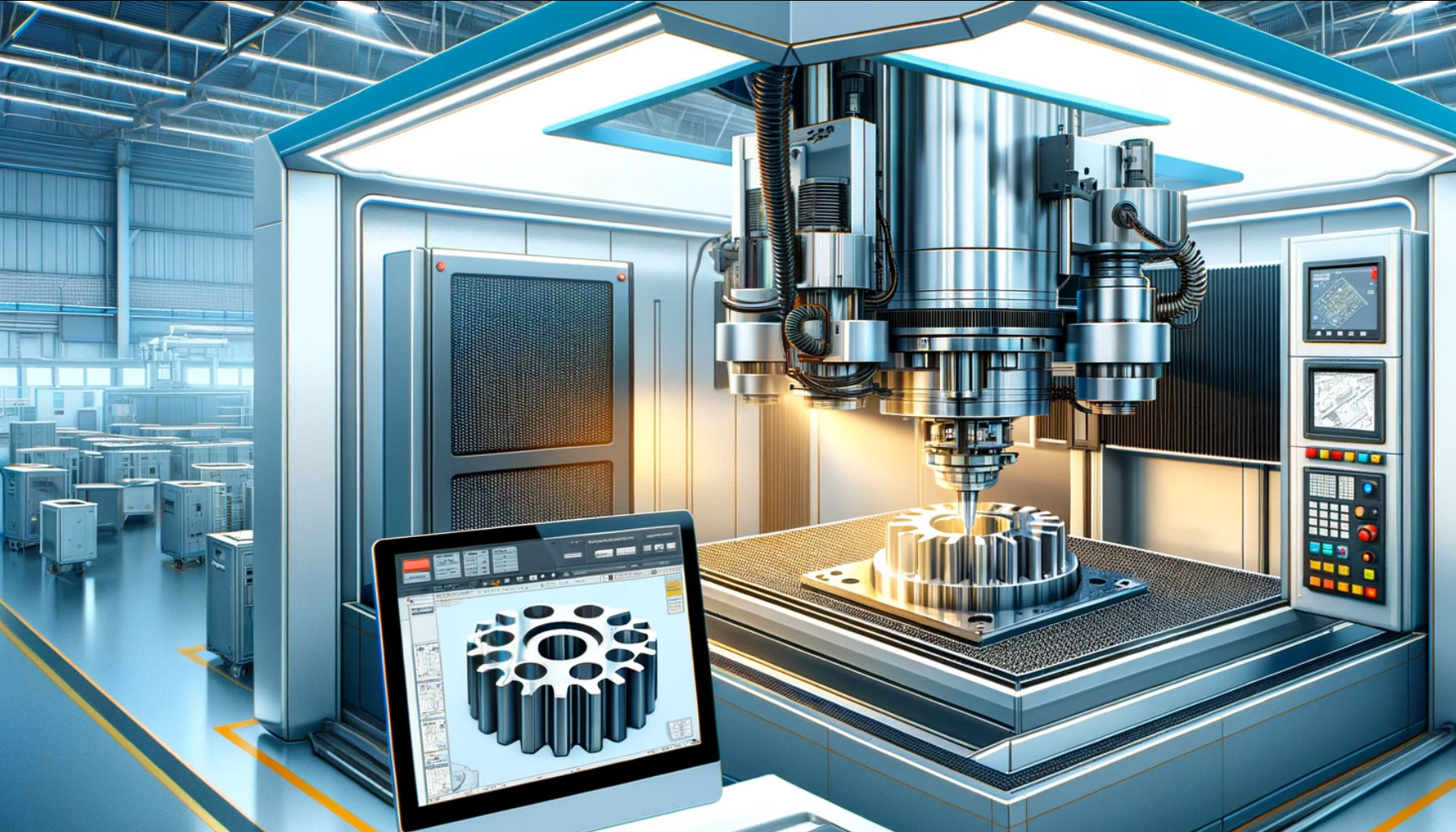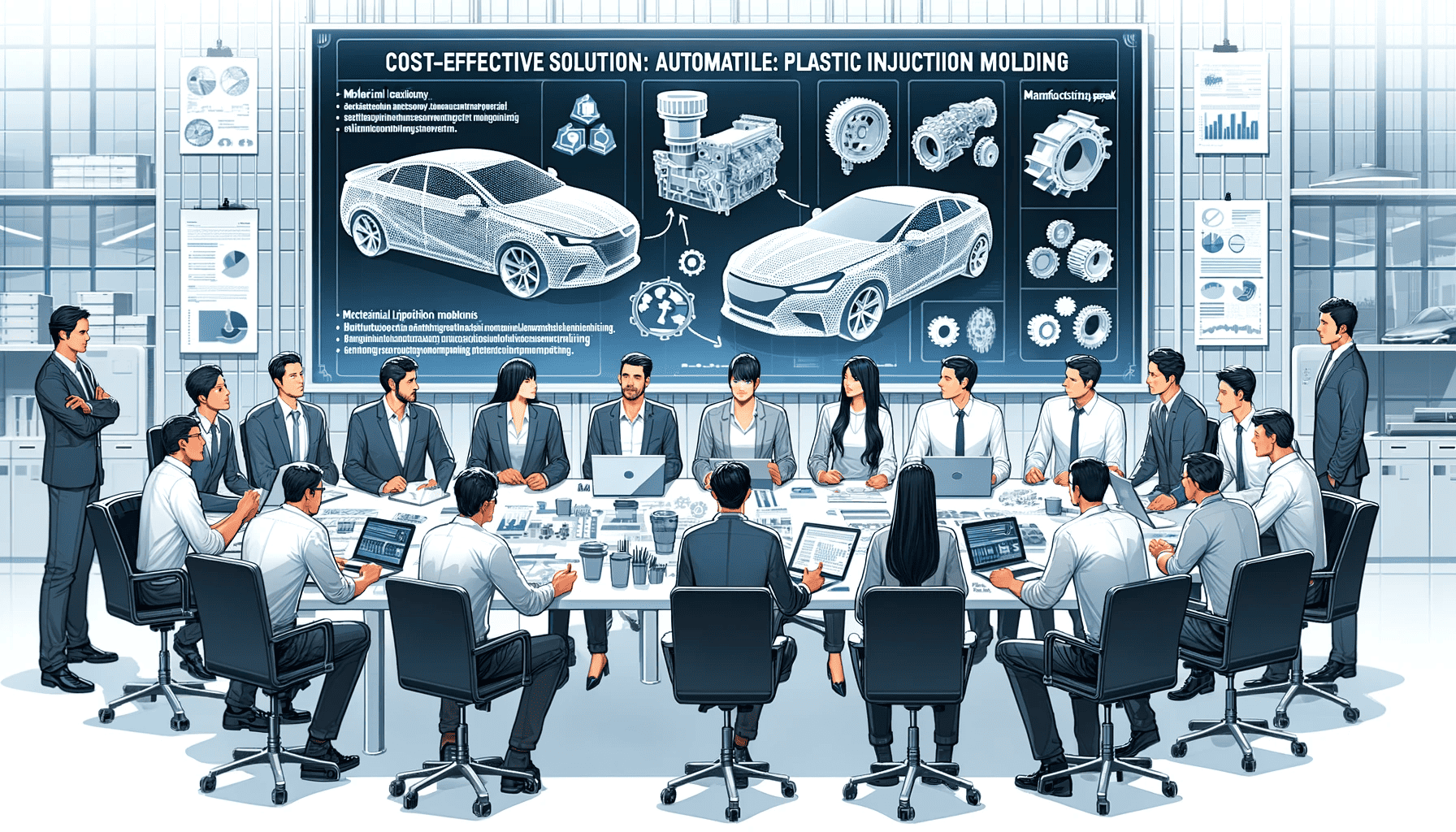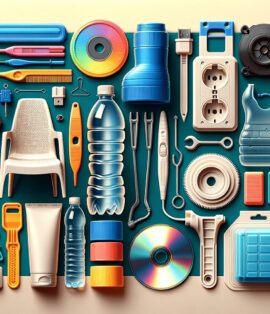
Injection Molding: The Manufacturing & Design Guide
Part 1: Introduction to Injection Molding and Molding Process
- Introduction to the versatility and efficiency of injection molding
- Detailed explanation of the injection molding process stages: clamping, injection, cooling, and ejection
Part 2: Materials in Injection Molding and Design for Manufacturability (DFM)
- Overview of materials used in injection molding: thermoplastics, thermosetting plastics, and elastomers
- Principles of Design for Manufacturability (DFM): simplification, standardization, and ease of assembly
Part 3: Wall Thickness, Ribs and Bosses, and Corners and Transitions
- Importance of uniform wall thickness for part integrity
- Design considerations for ribs and bosses to enhance strength
- The significance of radii, corners, and transitions in reducing stress concentrations
Part 4: Gate Location, Mold Design and Tooling, Surface Finish
- The impact of gate location on part quality
- The role of mold design and tooling in the injection molding process
- The influence of surface finish on the aesthetics and functionality of the part
Part 5: Advanced Techniques in Injection Molding, Quality Control
- Advanced techniques such as overmolding, insert molding, and gas-assisted injection molding
- Quality control measures including inspection, testing, and process monitoring
Part 6: The Role of Prototyping in Injection Molding
- The benefits of rapid prototyping and prototyping molds in the design validation process
- How prototyping can prevent costly errors in full-scale production
Part 7: Environmental Considerations in Injection Molding
- Strategies for material recycling and energy efficiency in injection molding
- The rise of bioplastics as a sustainable alternative in the industry
Part 8: Cost Considerations, Efficiency, and Choosing the Right Injection Molding Partner
- Discussion on material selection, mold design, and production volume for cost efficiency
- The importance of efficiency through automation, process optimization, and lean manufacturing
- Criteria for selecting the right injection molding partner for project success
Introduction to Injection Molding and The Injection Molding Process
Injection molding is a transformative manufacturing process that has revolutionized the production of plastic parts. It is the preferred method for creating high volumes of parts due to its high repeatability, precision, and ability to design complex geometries. This guide will delve into the intricacies of injection molding, providing insights into its processes, materials, and critical considerations for design and production.
The process begins with a detailed design phase, where engineers and designers collaborate to create a mold that can reliably produce parts to exact specifications. This phase is critical as it sets the foundation for the entire injection molding process.
Learn more about how we approach the injection mold’s design phase with precision and care.
The Injection Molding Process Explained
Injection molding is a cyclical process that includes the following key stages:
- Clamping – The mold must be securely closed by the clamping unit before injection begins. The required clamping force is determined by the projected area of the part and the pressure with which the material is injected. This force ensures that the mold stays closed during the injection process.
- Injection – Molten plastic is injected into the mold cavity. The amount of material, the injection pressure, and the injection speed are all critical parameters that must be controlled to ensure the quality of the part.
- Cooling – After the mold is filled, the plastic must cool and solidify. Cooling time is a function of the thermodynamic properties of the plastic and the wall thickness of the part. Cooling systems within the mold help to maintain a uniform temperature across the part.
- Ejection – The final step is to eject the cooled part from the mold. Ejection systems are carefully designed to apply even force across the part to prevent damage during removal.
Each stage of the process is monitored and optimized for the best quality and efficiency. Advanced injection molding machines are equipped with sensors and control systems that adjust process parameters in real-time.
Discover how our Injection Molding services ensure precision and quality at every stage.
Part 2: Materials in Injection Molding and Design for Manufacturability (DFM)
Materials Used in Injection Molding
The choice of material in injection molding is pivotal, as it dictates the part’s properties, such as strength, flexibility, and resistance to heat and chemicals. Here’s a closer look at the types of materials commonly used:
- Thermoplastics like Polyethylene (PE) and Polypropylene (PP) are widely used due to their recyclability and versatility. For instance, PE is known for its toughness and is commonly used in consumer product packaging.
- Thermosetting plastics undergo a chemical reaction during the molding process, which prevents them from being remelted. Epoxy resins, for example, are used in high-performance applications due to their excellent mechanical properties and resistance to high temperatures.
- Elastomers, such as silicones, offer exceptional flexibility and are used in applications requiring a soft touch, like medical devices or seals.
Learn more about the range of Plastic Molding materials we work with and their applications.
Design for Manufacturability (DFM)
DFM is the practice of designing parts to be easier and more cost-effective to manufacture. It involves simplifying designs to reduce the number of parts, standardizing components, and ensuring that the parts are easy to assemble.
- Simplification – By reducing the complexity of a part, it becomes easier to mold, which can lead to a reduction in production time and costs. For example, a bracket with multiple cutouts and undercuts can be redesigned to a simpler shape without compromising its functionality.
- Standardization – Using standard components in designs can reduce both the cost and time of production. For instance, standardizing screw sizes in a product can reduce the number of tools required for assembly.
- Assembly – Designing parts for ease of assembly can significantly reduce labor costs. Features like snap-fits can eliminate the need for screws and adhesives, speeding up the assembly process.
By incorporating DFM principles early in the design process, manufacturers can avoid costly redesigns and production delays. It’s a collaborative effort between designers, engineers, and manufacturers to ensure that the part is not only functional but also economical to produce.
Read about our Design & Engineering expertise and how we incorporate DFM into our projects.
Part 3: Wall Thickness, Ribs and Bosses, and Corners and Transitions
Wall Thickness in Injection Molding
Wall thickness is a critical design consideration in injection molding, as it affects the flow of plastic, cooling rates, and ultimately, the quality of the finished part.
- Uniformity – Maintaining uniform wall thickness helps prevent issues such as warping, sink marks, and incomplete filling. For example, a part design with walls that vary from 1mm to 4mm may result in uneven cooling, leading to internal stresses and a distorted part.
- Guidelines – Industry guidelines suggest a typical wall thickness for most materials ranges from 1.2mm to 3mm. However, specific applications may require adjustments; for instance, a part that must withstand high impact might need thicker walls for added strength.
- Optimization – Simulation tools can be used to optimize wall thickness for both performance and manufacturability, ensuring that the part can be produced reliably without material wastage.
Read more about how we optimize wall thickness for high-quality parts.
Designing Ribs and Bosses
Ribs and bosses are structural features that enhance the strength and functionality of injection molded parts without significantly increasing the weight or material usage.
- Ribs – Ribs should be designed to provide maximum strength with minimum wall thickness. They should be less than 60% of the adjoining wall thickness to avoid creating thick sections that cool unevenly.
- Bosses – Bosses, which are often used for assembly with screws or other fasteners, must be designed with proper support and radii to prevent cracking or stress concentration.
Corners and Transitions
Sharp corners and abrupt transitions can create stress concentrations and areas of weakness in a part.
- Radii – Adding radii to corners can distribute stress more evenly, reducing the risk of cracks or breaks. For example, a radius of at least 0.5mm is recommended at all internal corners.
- Transitions – Gradual transitions in wall thickness help prevent sink marks and ensure a more uniform fill and cooling. A taper or chamfer can facilitate these transitions effectively.
By carefully considering these design elements, manufacturers can create robust, high-quality parts that meet both functional and aesthetic standards.
If you are looking for more details about how to ensure the highest quality in plastic part design, please contact our team and we will guide you through.
Part 4: Gate Location, Mold Design and Tooling, Surface Finish
Gate Location in Injection Molding
The gate is where the molten plastic flows into the mold cavity, and its location is critical for the quality of the final part.
Gate Placement – The gate should be placed at the thickest section of the part to allow for gradual cooling and minimize visual defects. For instance, improperly placed gates can lead to weld lines, which are weak points in the part.
Gate Types – There are several types of gates, such as edge gates, tab gates, and submarine gates, each with its own application depending on the part geometry and functionality.
Gate Removal – After molding, the gates must be removed, which can be done manually or automatically. The method of gate removal can affect the appearance and function of the part, so it must be considered during the design phase.
Read more about how our Injection Molding process ensures optimal gate location for every part.
Mold Design and Tooling
The mold is the heart of the injection molding process, and its design is crucial for producing high-quality parts.
- Mold Materials – Molds are typically made from steel or aluminum, with steel being used for high-volume production due to its durability, and aluminum for prototypes or short runs due to its cost-effectiveness and better thermal conductivity.
- Mold Machining – Precision machining of the mold is essential for achieving the desired part tolerances and surface finish. Advanced CNC machining techniques are used to create molds with complex geometries and fine details.
- Mold Maintenance – Regular maintenance is necessary to ensure the mold continues to produce quality parts and to extend its life. This includes cleaning, repairs, and periodic refurbishing.
Surface Finish
The surface finish of the part is directly influenced by the finish of the mold cavity.
- Finish Types – Surface finishes range from high gloss to textured, and the choice depends on the part’s aesthetic requirements and functionality. Textured finishes can hide imperfections and improve grip, while high gloss is often used for visible consumer parts.
- Polishing and Texturing – The mold surface can be polished to a mirror finish or textured by methods such as bead blasting or chemical etching, depending on the desired outcome.
By carefully considering gate location, mold design, and surface finish, manufacturers can significantly impact the functionality, appearance, and production efficiency of injection molded parts.
Part 5: Advanced Techniques in Injection Molding, Quality Control
Advanced Techniques in Injection Molding
Innovation in injection molding has led to advanced techniques that expand the capabilities and applications of this manufacturing process.
- Overmolding – This process involves molding a second material over a previously molded part to create a single part with multiple properties. For example, a soft rubber grip on a toothbrush handle is typically created using overmolding.
- Insert Molding – Metal or different plastic inserts are placed into the mold cavity and then the plastic is injected around them. This is commonly used for parts that require threaded inserts or metal components for reinforcement.
- Gas-assisted Injection Molding – Gas (usually nitrogen) is injected into the mold cavity after the plastic to create hollow sections within the part. This technique reduces weight and material usage without compromising strength.
These techniques require precise control and advanced mold design to achieve the desired results and are used to enhance the functionality, aesthetics, and performance of the final product.
Explore our article “Automotive Plastic Injection Molding, A Cost-Effective Solution” to read more about techniques and how they can benefit your project.
Quality Control in Injection Molding
Quality control is integral to the injection molding process, ensuring that each part meets the established standards and specifications.
- Inspection and Testing – Parts are inspected for dimensional accuracy, material properties, and surface finish. Testing can include pressure tests, leak tests, and stress tests to ensure the part performs as expected under real-world conditions.
- Process Monitoring – Real-time monitoring of the molding process allows for immediate adjustments to maintain quality. Parameters such as temperature, pressure, and cycle time are tracked to ensure consistency.
- Continuous Improvement – Feedback from the quality control process is used to make ongoing improvements to the mold design, material selection, and process parameters, driving higher quality and efficiency.
Quality control not only ensures that each part meets the required standards but also contributes to the overall efficiency and cost-effectiveness of the manufacturing process.
Part 6: The Role of Prototyping in Injection Molding
Before full-scale production begins, prototyping is an essential step in the injection molding process. It allows for the validation of part design, functionality, and manufacturability.
- Rapid Prototyping – Techniques such as 3D printing or CNC machining enable the quick creation of prototypes that closely resemble the final injection molded parts. This allows for hands-on testing and evaluation.
- Prototyping Molds – Aluminum molds can be used for prototyping due to their lower cost and faster production time. These molds provide a preview of how the part will be produced in the final steel mold.
- Design Validation – Prototyping is crucial for validating the design, ensuring that the part fits with other components, meets strength requirements, and has the desired appearance.
Prototyping is a cost-effective way to identify and address potential issues before they become costly during full-scale production.
Explore our Rapid Prototyping services to see how we can streamline your product development process.
Part 7: Environmental Considerations in Injection Molding
Sustainability is becoming increasingly important in manufacturing. Injection molding can be adapted to be more environmentally friendly.
Material Recycling – Many thermoplastics used in injection molding can be ground up, recycled, and reused, reducing waste and the need for virgin materials.
Energy Efficiency – Modern injection molding machines are more energy-efficient, using precise controls to minimize energy consumption during production.
Bioplastics – The use of biodegradable materials or bioplastics is on the rise. These materials can provide similar qualities to traditional plastics while being more environmentally friendly.
By incorporating these environmental considerations, companies can reduce their carbon footprint and appeal to eco-conscious consumers.
Part 8: Cost Considerations, Efficiency, and Choosing the Right Injection Molding Partner
Cost Considerations in Injection Molding
Cost efficiency is paramount in injection molding, as it impacts the overall profitability and viability of a product. Several factors contribute to the cost-effectiveness of the injection molding process:
- Material Selection – The cost of different polymers varies significantly. Selecting an appropriate material that meets the part requirements without over-specifying can lead to substantial cost savings.
- Mold Design – A well-designed mold can reduce cycle times and increase the longevity of the mold, both of which contribute to lower costs per part.
- Production Volume – The number of parts produced has a direct impact on cost. Higher volumes can dilute the initial mold cost over more parts, reducing the cost per unit.
Efficient production and careful planning can significantly reduce the costs associated with injection molding, making it a competitive option for mass production.
Discover how to “Estimate Injection Molding Cost” in our latest article.
Efficiency in Injection Molding
Efficiency in injection molding not only refers to the speed of production but also to the optimization of the process to reduce waste and energy consumption.
Automation – Implementing automation in the injection molding process can lead to more consistent parts and reduce labor costs.
Process Optimization – Fine-tuning the injection molding parameters for the shortest possible cycle time that still produces quality parts can result in significant efficiency gains.
Lean Manufacturing – Adopting lean manufacturing principles in injection molding operations can minimize waste and streamline the production process.
Efficiency improvements in injection molding not only reduce costs but also enhance the sustainability of the process.
Choosing the Right Injection Molding Partner
The success of an injection molding project is heavily dependent on the expertise and capabilities of the manufacturing partner.
Technical Expertise – A partner with a deep understanding of injection molding can provide valuable insights into material selection, design optimization, and process efficiencies.
Quality Assurance – A reliable partner will have robust quality assurance processes in place to ensure that each part meets the required specifications.
Customer Service – Good communication and service are essential for navigating the complexities of an injection molding project and ensuring that the final product meets the client’s needs.
Choosing a partner like LK MOULDS, with a proven track record and a commitment to quality, can make all the difference in the success of your injection molding project.
Contact us to see how our Tool-Making and Mold Production services can bring your project to fruition with the highest standards.
Our team is here to answer your questions
Let’s talk about your Project
Relatetd Post
Recent Posts
- CNC Machining: The Key Advantages for Efficient and Precise Rapid Prototyping
- Prototyping: 3D Printing vs. CNC Machining
- Automotive Plastic Injection Molding: A Cost-Effective Solution
- Injection Molding: The Ultimate Manufacturing & Design Guide
- What is CNC Machining? A Comprehensive Overview of Precision Manufacturing







Comments are closed